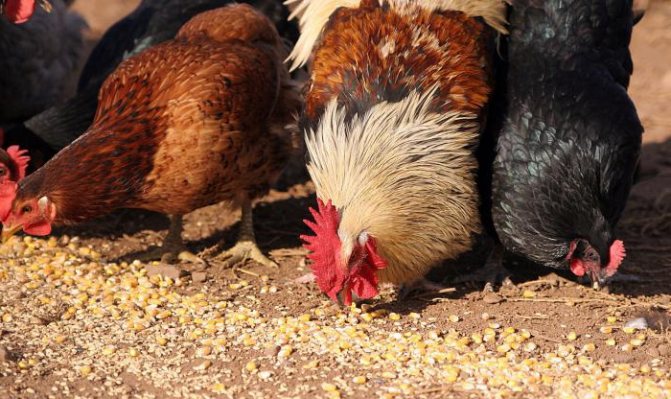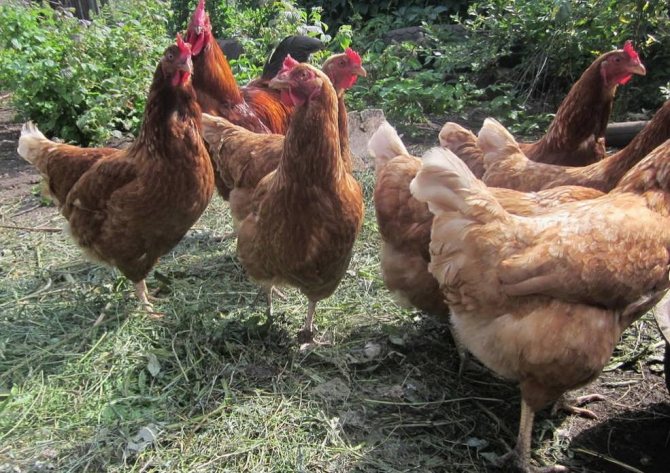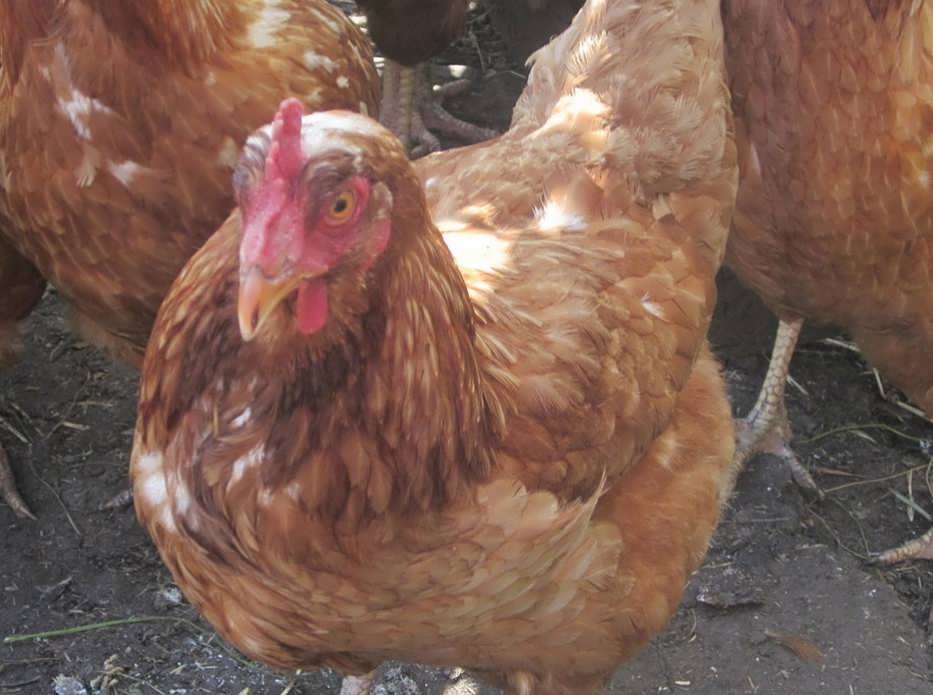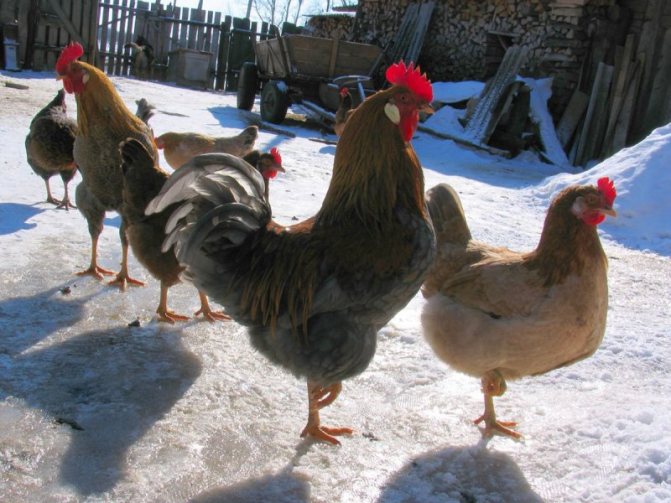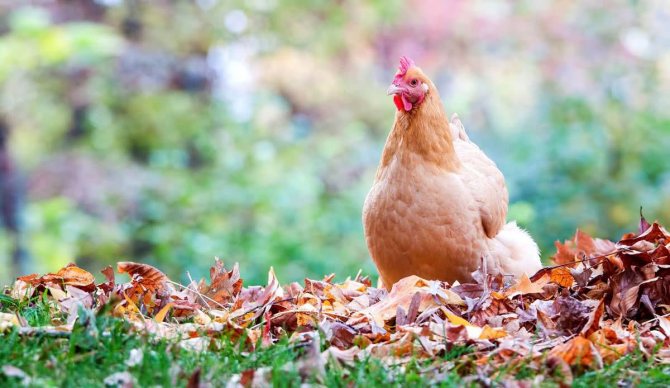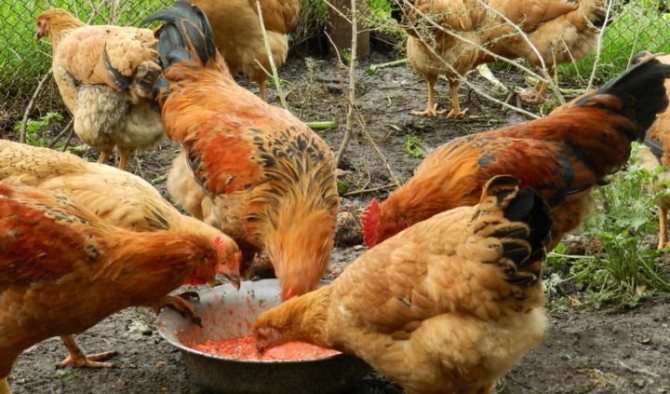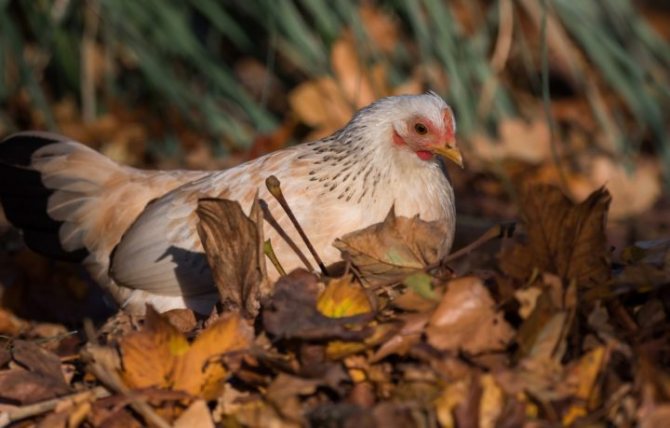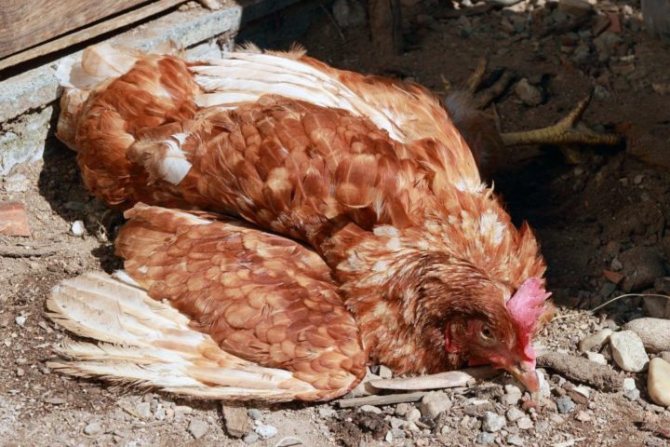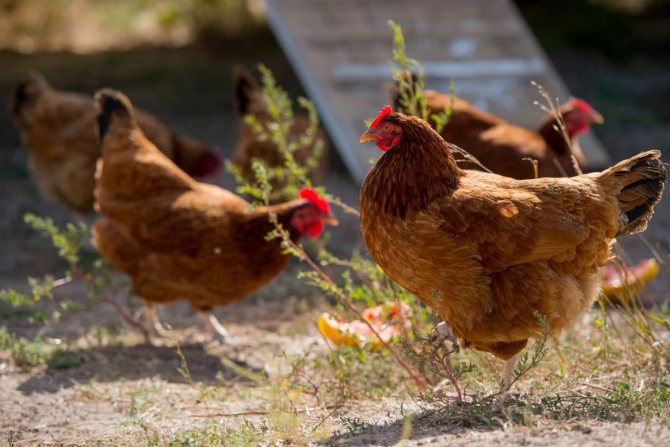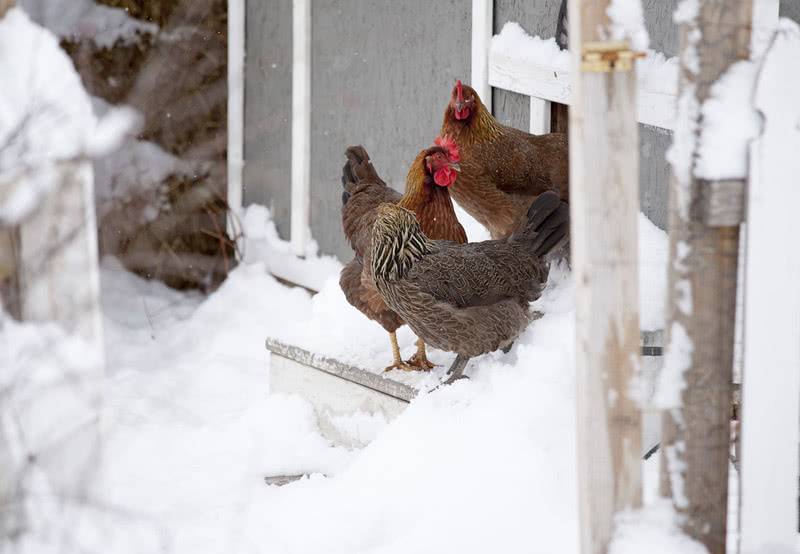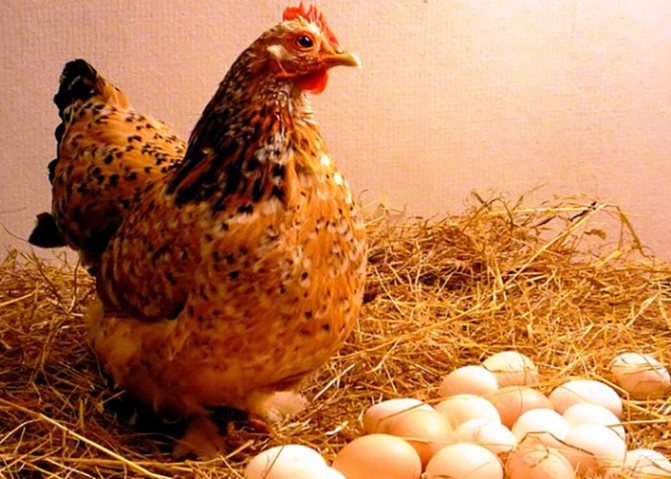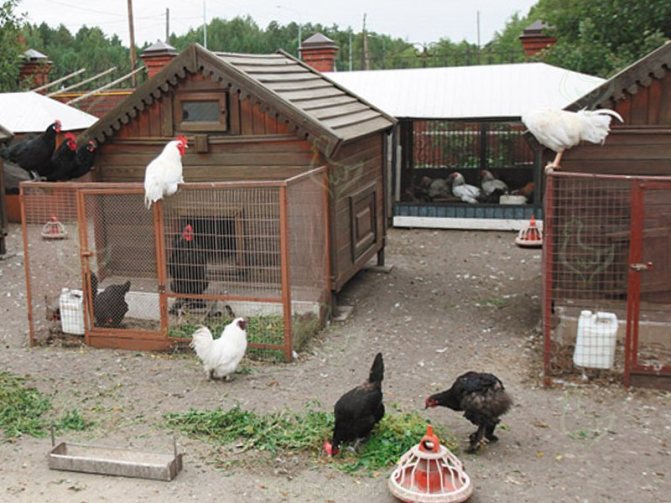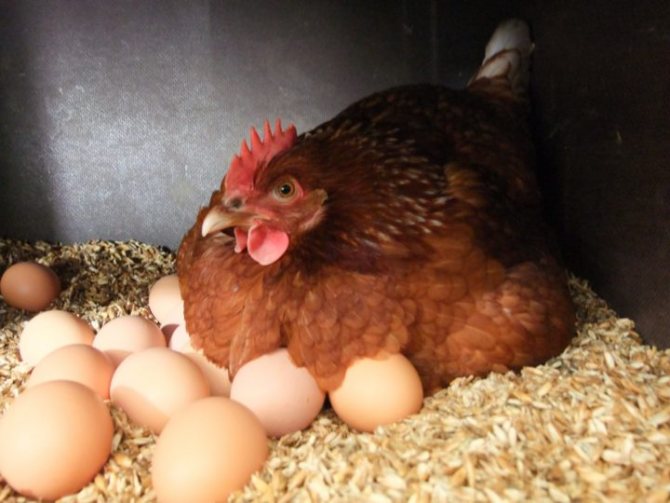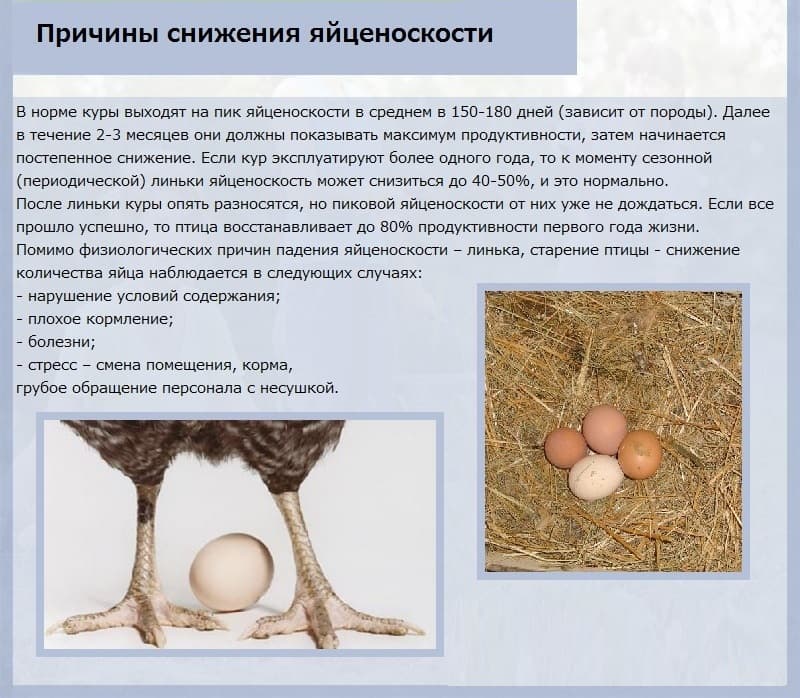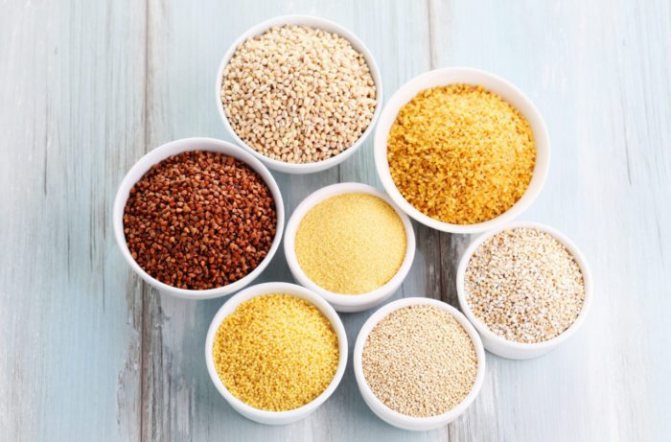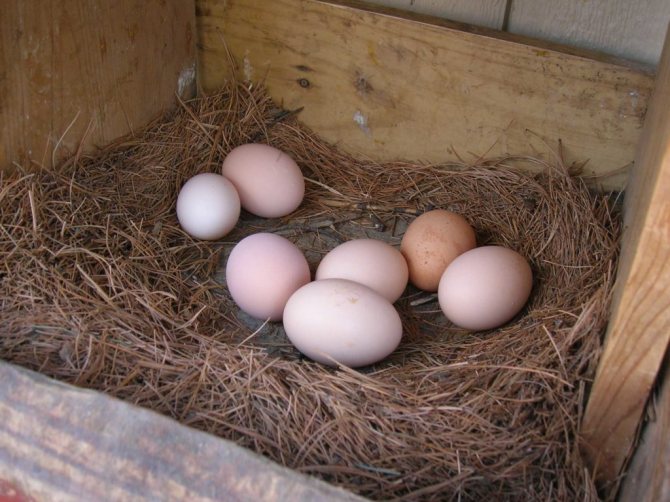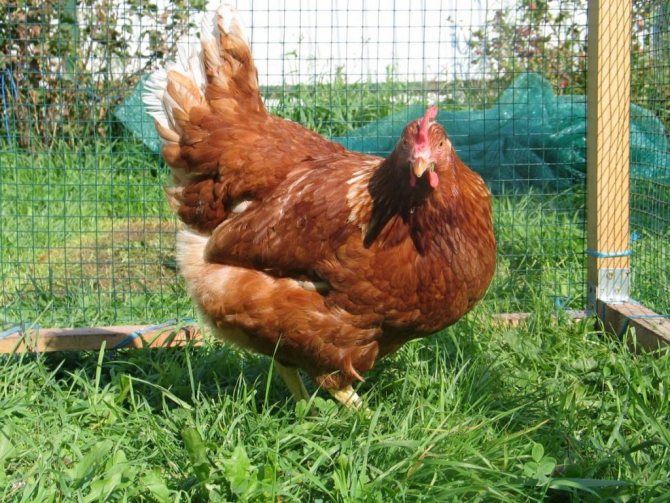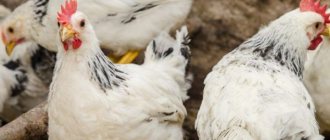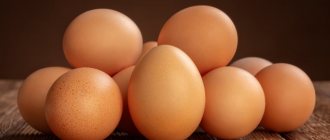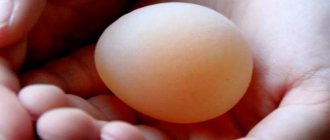Chickens stopped laying eggs
To understand the problem, you should consider everything in order.
The beginning of egg production
Young laying hens willingly visit the nests. The start of laying period depends on:
- genetic, breed data;
- feeding;
- content.
Finding out at what age young chickens rush without knowing the breed is pointless. If one begins to lay at 4.5 months, then the other can at 6, and this is normal. The only thing that is certain is that you cannot rush the bird. If pullet chickens have not reached the "necessary" condition and entered the egg-laying, then it will not be long, and such a bird will go to cull early.
The chickens lay small eggs for the first 2-3 weeks. Further, it becomes larger. During this period, it is important to have a sufficient number of nests. If they need to rush at the same time, then additional nests will satisfy the needs. Normally, one nest is calculated for 5-6 chickens.
Mid-cycle
In summer, the egg becomes large, but the nest is less frequently visited. The heat is doing a disservice. When the bird stands with its wings spread out and looks for a shade, egg production drops. During this period, it is very important to organize:
- constant access to fresh water;
- shaded space.
Crowding should not be allowed. If there is no free range, then 5 chickens should have at least 1 m2 of area.
Pecking eggs
If the chickens do not have a walk, then egg beating is added to the poor egg production. The birder watches the hen visit the nest, sit,
ostensibly laying, but no eggs. How to check if chickens are rushing?
If the feeding ration is disturbed (mineral deficiency with the norm of protein), then the chickens will lay eggs, but they will eat them. And not even the eggs themselves attract attention, but the shells - in chickens, the lack of calcium in the body will be clearly traced.
In this case, you need to immediately increase the amount in the diet:
- meat and bone meal;
- fish meal;
- dairy waste (whey, return);
- mineral feeding (tricalcium phosphate);
- stern shells.
Housing errors affecting the performance of hens
The number of nests and their arrangement affect productivity. Nests are arranged in places where no one bothers the chicken at the time of an important mission. The litter should be clean and soft. One nest is arranged for 6 individuals. If the place for laying is unsuccessful, the eggs will be scattered, and there not long before pecking. This is dangerous. If the chicken tastes the contents, it will hunt for delicious food. Therefore, it is impossible to allow the appearance of eggs without shells, pouring. Productivity decreases, in the future there will be a threat of pecking. It is necessary to add mineral dressing.
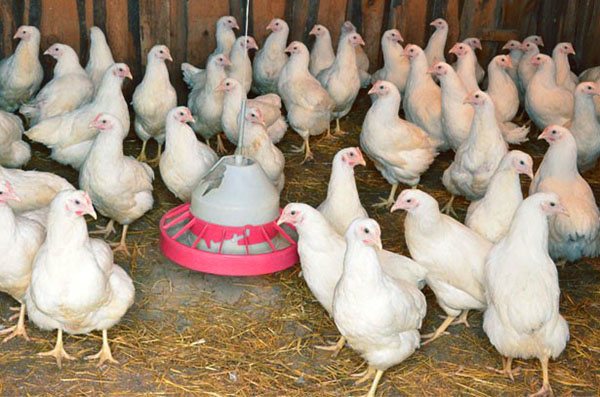
Why did the laying hens stop laying with good care? Perhaps, with free range, the cunning ones organized a new nest in a secluded corner. After a while a brood hen will sit on it and a flock of unplanned chickens will appear. Collecting eggs every day and a careful survey of the area will solve the problem.
Often, pullets that have begun to rush stop laying. They are more stressed than adult chickens. Moving to another chicken coop, the appearance of a rooster, a night thunderstorm with thunder cause the lack of eggs. Adding 20 ml of apple cider vinegar a day for a week will help.
During the molt of pullets in the fall, the productivity of layers decreases sharply.It is necessary to exclude grain from the diet and new feathers will grow faster, the clutch of eggs will be restored. After fouling, give cereals to birds with seedlings to restore productivity. You need to feed such chickens 3-4 times a day.
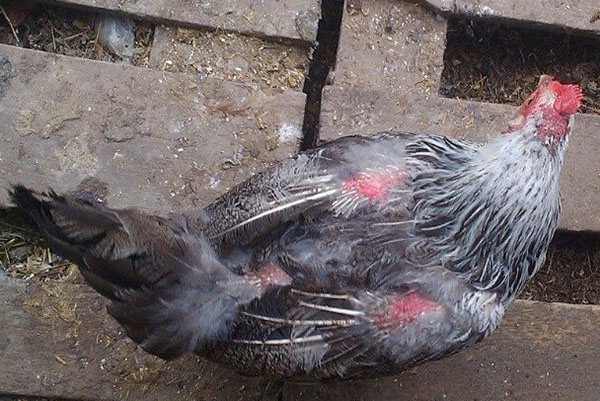

To prevent the bird from contracting infectious diseases, it is necessary to be vaccinated against diseases that are common among birds in the region. When free-roaming, you can infect a flock from wild pigeons or crows.
Anxiety and stress in laying hens, a decrease in egg production, will cause parasites that have settled in. If the chickens are restless, they are constantly plucked, it's time to put them an ash-sand mixture. Fluttering in it will get rid of feathers and ticks. Internal infection can be expelled with anthelmintic drugs. Sanitize the chicken coop.
When choosing a laying hen for a household, you need to take a light individual, weighing 1.5 kg. Feathers should be shiny, dense. The comb of the chicken is bright red.
How to determine whether a chicken is rushing or not
To know whether chickens are rushing or not, you need to follow the nest. There are several options:
- If chickens lay but eat eggs, then a wet spot (broken egg) and traces of yolk on those eggs that they did not have time to eat will be visible;
- If a chicken sits in a nest, but does not rush and does not get up at night, then most likely she wants to become a brood hen. In this case, she does not lay, but “picks up” all the eggs for herself. To check, it is enough to pick up all the eggs, and she will walk. As soon as at least one egg appears in the nest, it will certainly sit on it;
- To find out which chickens are rushing and which are not, you can mark them. In the hen house they put a bottle of green stuff (a pharmaceutical preparation of a brilliant green solution) and a stick with a tampon at the end. You need to look into the chicken coop often and mark the chicken that sits in the nest with green stuff. Thus, in 3-4 days it is possible to "mark" those who visit the nest.
To know for sure how often laying hens fly, the bird can be placed in a separate cage and watched.
Molting
For this reason, chickens may stop laying several times a year. However, usually, the decrease in egg production due to molting does not cause particular concern to the owners. The fact is that replacing a feather with a new one in chickens usually lasts a very short time - no more than 8-10 days. Autumn and reduced daylight hours are the main reason chickens molt and do not rush. What to do in this case? Nothing, of course. You just need to wait until the end of the molt.
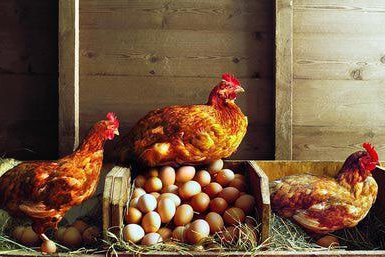

Feeding is the basis of egg production
If there are 10 chickens in a flock, and there are only 5-6 eggs, then this may mean that:
- The diet is not rich in protein enough;
- The diet is balanced, but the feed is not digestible.
For the synthesis of eggs, proteins are needed. If there is no animal feed in the diet, the chickens do not lay. A bird cannot “produce” 50 g of protein every day if it does not enter its body. Of course, cereals also have protein, but poultry needs essential amino acids that are only found in animal feed. With the addition of meat and bone meal, skim milk, meat production waste to the diet, egg production will recover in 9-12 days.
When laying hens begin to lay, their body is still capable of producing an egg "from itself". Further, the law of self-preservation works more and more, and egg production stops.
Why don't laying hens fly if the diet is balanced? Possibly feed is in transit. This pathology happens if the chickens are in closed cages without walking and there are no sand and pebbles in the feeders.
Diseases
The disease can also cause chickens not to lay. What to do in this case is clear. We need to call the vet. Most often, a decrease in egg production in chickens occurs due to the fact that they have worms or some other parasites. There are also alternative methods of treating sick birds.For example, diphenhydramine is sometimes used as an anthelmintic agent. A few drops of it are added to the drink for chickens.
It is possible to determine the presence of worms in chickens, including by external signs. Symptoms of helminthiasis in chickens are weight loss, swelling of the joints, as well as the appearance of nodules in the mouth and on the skin. In the event that feather parasites are bred in chickens, a trough with ash is placed in the shed.
However, it is still worth treating chickens on your own only in the most extreme cases. The bird can simply be ruined. It is better to call your veterinarian and follow the recommendations given by him.
Egg production
Chickens begin to rush at the age of 20-22 weeks. The meat breed will please with an egg already at the age of six months, a mongrel bird will lay the first egg after eight months. In addition, egg-laying depends on the diet, conditions of detention. Eggs at the beginning are usually in the range of 40-50 grams, gradually the weight increases to 60-70 grams.
Egg production depends from the breed of bird, the reasons for the poor performance are also from them. The following breeds are distinguished:
- Meat and outbred (these include Adlerovskaya Serebristaya, Amroks, Arshotts) differ in the average clutch of eggs, about 200 eggs per year, however, require warm conditions;
- Egg (we include Leghorn, Loman Brown, white Hisex, Breckel) can bring more than 300 eggs a year;
- Broiler meat house - they are characterized by low egg production, which is natural, since the main purpose of their maintenance is to obtain a large amount of tasty and tender meat.
An interesting case is known: the laying hen brought 371 eggs to the owners during the year! More often the bird rushes every other day. The number of years lived by the chicken is also important. High productivity is recorded in the first two years of life, gradually the indicators are falling. The chicken is capable of laying eggs until it reaches four years of age.
Any farmer forms his own a herd of laying hens in two ways:
- It is acquired by a modern breed of crosses;
- She starts an unpretentious breed of laying hens.
Breed
Among the variety of chicken breeds, egg, meat and meat breeds are distinguished. Some of them lay eggs daily, while others have their own schedule.
When purchasing a chicken, decide on the purpose of the content. So egg breeds of chickens lay about 300 eggs per year, but their meat is hard, tasteless, and takes a long time to cook. Meats will delight you with wonderful meat, but their egg production is low. Tender meat and egg-laying of 200 pieces per year are obtained from meat-bearing species. Therefore, the cessation of egg production can be normal and a sign of the breed.
Why did the chickens stop laying?
How to increase egg production in laying hens? What to do for this? Do some chickens delight with an egg every day, while others do not? How to increase the productivity of laying hens, achieve high rates of egg production and what are the reasons for its decline on large farms and small backyards?
Why did the chickens stop laying eggs?
If the chickens stop laying, then you should first pay attention to the temperature regime in the barn. Under comfortable, warm conditions in the hen house there will always be a high egg production. A room that is too cold or too hot will immediately affect the birds. In winter, we insulate the house as best as possible, thereby ensuring at least 15 degrees in the room. In winter, chickens devote a lot of energy to heating their own bodies, instead of spending it on laying eggs. Eliminate unnecessary energy consumption, while insulating the chicken coop, and you will get a good clutch of eggs.
Why do chickens fly badly in winter and autumn?
The season has a direct impact on the process of laying eggs. Many farmers ask questions: why did the chickens stop laying in the fall, or why the chickens do not lay in the winter? What to do about it? What does the season have to do with it?
Egg production of chickens in winter drops sharply due to subzero temperatures, since the bird spends a certain amount of energy to heat the body. Laying hens are very whimsical to temperature, they rush well in warmth. Reduced daylight hours, temperature drops, a large number of chickens in the house are the reasons for poor performance. Eliminating these negative aspects will surely bring the desired result, and chickens will begin to rush in winter like in summer.
In addition, in winter, laying hens are in dire need of vitamins and additional feeding.
With the onset of spring, unfortunately, some chickens are in no hurry to please with an egg, which is also associated with a small amount of vitamins... Walking outdoors soon fixes the problem.
What if the hens don't lay eggs in summer and autumn?
Sometimes egg production drops sharply in the summer, at a time of year when there are a lot of useful trace elements and vitamins in the diet. What is the reason for this? Most likely, the bird is sick (an infectious or parasitic disease). Sometimes the eggs are stolen by rats or the bird independently changes the place of laying the eggs. In autumn, molt also negatively affects egg production (except for low temperatures). Do not worry, as molting is a natural process associated with short daylight hours.
To eliminate this cause low egg production, you can resort to artificial lighting by building a lamp in the chicken coop.
How to keep poultry properly
It is important for these birds that the room in which they are located is spacious. One square meter should be allocated for five layers. If you plan to breed offspring, then a rooster should live in the hen house, which is at least four years old. He is able to fertilize about a dozen females. But this factor does not at all affect the productivity of the layers themselves.
In the hen house, the air temperature should be at least twenty-two and not higher than twenty-five degrees. When the weather is hot outside, you need to take care of the canopy and shade the room to reduce the temperature inside.
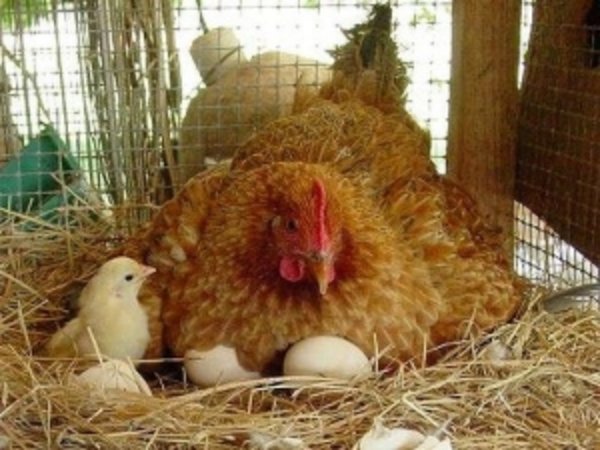

Hen in the hen house
In winter, daylight hours are extended to fourteen or even sixteen hours by installing artificial lighting. At the same time, you need to take care that it is not too harsh. It is imperative that during the winter period there is a walk for the livestock of birds with bathing in ash and sand. Thanks to this, the chickens will feel comfortable. If the females have stopped laying eggs, the reason is found out, and it is determined what to do in this case.
First of all, the conditions of their maintenance, the diet are revised, and if necessary, adjustments are made.
It must be taken into account that the menu for chickens should be as follows:
- 120 grams of grain mixture per day consists of:
- corn - forty percent of the total mass;
- wheat - twenty percent;
- barley - twenty percent;
- oats - thirty percent.
- 100 grams of boiled potatoes.
- 30 grams of mash.
- 3 grams of chalk.
- 7 grams of cake.
- gram of baker's yeast.
- 2 grams of bone meal.
- half a gram of table salt.
If the diet includes ready-made dry food for layers, then it is imperative to pour the grain mixture separately.
Important! In the summer, laying hens are fed with a mash of bran and herbs, thanks to which their body receives the necessary amount of vitamins. In winter, it is replaced with premixes.
Adults should eat twice a day, and be sure to give dry food in the evening. In the morning they give a mash, but it should be remembered that you cannot overfeed the bird, because it will become fat and become unproductive. During the day, be sure to give gravel or shells, so the birds will process food. Stones tend to grind food in the stomach of birds, like millstones. It is important for birds to drink enough water.
In order for the chickens to fully rush, their diet must be varied and full of vitamins and herbs.If the birds are swimming and fluttering, this means that they have enough food and drink.
Problem solving methods
Increase the number the eggs obtained daily can be done in several ways. Let's list some of them:
- Provide a healthy diet enriched with green herbs, roots, minerals, vitamins;
- It is important to maintain the correct air temperature in the hen house - 15–20 degrees (additional heating or insulation in winter, in summer there are many shady places and fresh, cool water);
- We detect diseases and parasites in time;
- Large space for laying hens, eliminating crowding in a small area.
Age
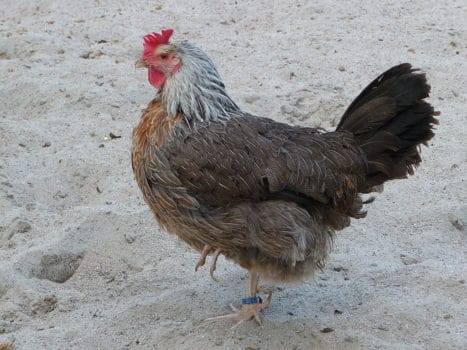

Laying eggs begins at the age of 4-6 months and is most productive until the second year of life, after which it decreases annually by 15-20%. To prolong the productive age of birds, some poultry farmers inoculate them with a special preparation in the spring. But by the age of 5, egg production inevitably falls to an unprofitable level, and nothing can be done about it. When buying livestock, two-week-old chicks or incubation material should be taken to avoid falling prey to adult age deception.
How many chickens to keep in one chicken coop?
Overcrowding of chickens also negatively affects performance. The farmer must consider correct number and arrangement of nests... For nests, it is best to choose a calm and secluded place in which the bird will feel optimal for the important mission of laying eggs. Nests should be made at some distance from each other so that one bird does not interfere with the other. Don't forget about the cleanliness of the litter!
On average, one nest is counted for six layers. Incorrect socket position is fraught with throwing and pecking eggs, which becomes a very unpleasant fact. If a chicken tastes an egg once, it remembers tasty food and will hunt in the future, constantly spoiling the eggs.
Chickens are fat: reasons.
The first reason is improper feeding, in particular, an excess of cereals (corn, wheat) or sunflower meal. This often happens, for example, if a poultry farmer has a lot of corn and in order not to spend money on buying other feed, practically only corn is used for feed for chickens, as a result of obesity of layers.
It has been noticed that chickens often get fat if they are fed a lot of steamed grains of wheat or corn, boiled grains are more easily and quickly absorbed by the body, and in case of overdose, this leads to obesity.
The second reason for obesity in chickens is a sedentary lifestyle, if chickens are kept in small open-air cages and cramped chicken coops, where the bird does not have the ability to move a lot, then the chickens can begin to fatten.
The third reason is the lack of green fodder, chickens need green fodder every day, especially in summer. If the chicken does not get enough green feed, then it replaces it with compound feed and grain, as a result of obesity.
Laying hens ration
Correct feeding and feed change - the key to the success of laying hens. In the case of a shortage of useful elements and vitamins, you should not count on high egg-laying rates. Laying hens may stop laying if they are not fed regularly.
In the diet of chickens, cereals (wheat, corn, oats, barley) are mandatory. The shell of eggs is formed from minerals that enter the body (for example, chalk, bone meal, salt, shells).
A few rules for a healthy diet:
- Feed the chickens before turning on the light in the hen house;
- The diet includes carbohydrate and protein components;
- The daily rate for each layer is 130–150 grams.
A feed with a vitamin complex has a good effect on the number of laid eggs, to which it is beneficial to add fresh grass, flour, etc. Laying hens are fed with different types of feed: dry and wet.At the same time, it is recommended to use crushed grain during the day, and whole grain at night, since whole grains are digested in the body much longer, which allows you to suppress the feeling of hunger for a long time.
Chicken nutrition
In order for the bird to be productive in terms of carrying eggs, it must be fed correctly and regularly. Lack of any vitamin causes a decrease in the number of eggs. Poultry feed should include many types of grains - wheat, barley and oats, as well as vegetables and herbs. To improve the shell, chickens must receive minerals - chalk, bone meal or shell rock.
It is good for chickens if they have the opportunity to walk freely around the territory. They can independently search for the missing batteries for themselves. Salt is also very necessary, but it must be sprinkled fine or dissolved in water. It improves the appetite of chickens very well.
In warm, and especially hot, time, chickens need clean water. It should be a little cool (about 15 degrees). Most of all, the bird drinks water after wearing or before bedtime.
Access to water
Egg production rates are declining due to the lack of a clean source of drinking. Lack of water significantly reduces productivity. In the summer, hens are often very thirsty. Clean and cool water (within 10 - 15 degrees) should always be in the chicken coop. Chickens are especially thirsty before bedtime and immediately after laying the eggs.
In production, the egg production of birds is increased by modern means, which guarantees constant productivity. But in order for the chicken to lay eggs, it needs to create the appropriate conditions. There are many factors that can be the reason why chickens stop laying. To fix the problem, you need to identify its source.
How to solve the problem with egg production in the autumn season?
During seasonal periods, there is a sharp decline in egg production. Poultry farmers need to know what to do to strengthen the chicken's body in the fall.
The first thing to look at is nutrition. It is necessary to feed the birds in the morning. It is recommended to mix different types of grains for productivity. Use only whole grains for feeding.
Also watch the weight of the bird, do fasting days. The essence of the fasting day is to replace the morning and evening feeding with water and grass.
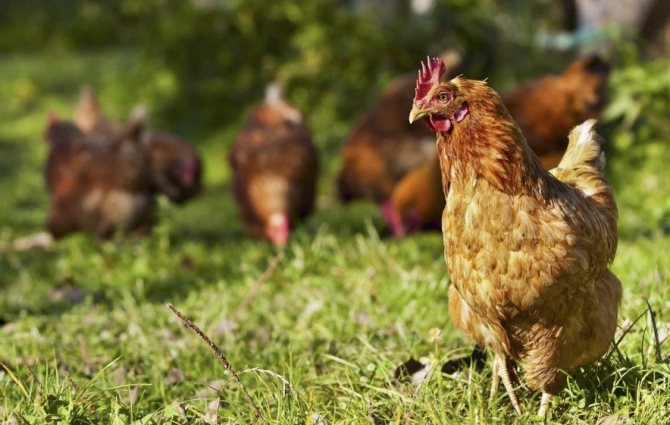

In the autumn, the feeding rate per individual is as follows:
- fresh herbs - 20 grams;
- whole grains - 45 grams;
- crushed grain - 55 grams;
- carrots - 20 grams;
- chalk - 4 grams.
We recommend that you find out why there is blood in a chicken egg.
Chicken food is supplemented with minerals and vitamins, the largest amount of which is found in greens, vegetables and root vegetables. Another way to increase the egg production of chickens is to prepare feed in advance: they can be crushed, yeast or sprouted. These types of feed allow the chicken to easily digest food and fill the body with useful elements.
Top 9 reasons for the decline in egg production
Scientists have identified nine main reasons why chickens stop laying eggs. Violation of keeping conditions, diet, stressful situations and belonging to the breed play an important role in the egg production process.
Lighting
Changes in daylight hours or improperly organized artificial light can lead to an imbalance in the bird's body, which will affect its egg production and egg quality. For a hen to feel normal, it is required to provide a day of light from 12 to 15 hours. And since in winter you cannot get the right amount of light during the day with the help of the sun, therefore it is recommended to install lamps with warm white or dim red light. If the bird is indoors without walking, then the lighting should be strictly adjusted by the clock.
Temperature
If it is too cold or too hot in the hen house, then the number of eggs obtained from the hens will greatly decrease, and in winter it is dangerous because the chickens may freeze.The temperature of the chickens is an important factor affecting egg production. The optimum air temperature is from 12 to 18 degrees Celsius.
If you want to receive eggs from laying hens all year round, then in winter it is necessary to put additional heating in the hen house and make sure that there are no drafts, and in summer you should ventilate the room with nests well every day.
Air humidity
If the chicken is kept in a room with very dry air, this will affect its feathers, and various kinds of dermatitis may begin. High humidity is also bad. In order to prevent health problems of the bird, you need to regularly ventilate the chicken coops, avoiding drafts.
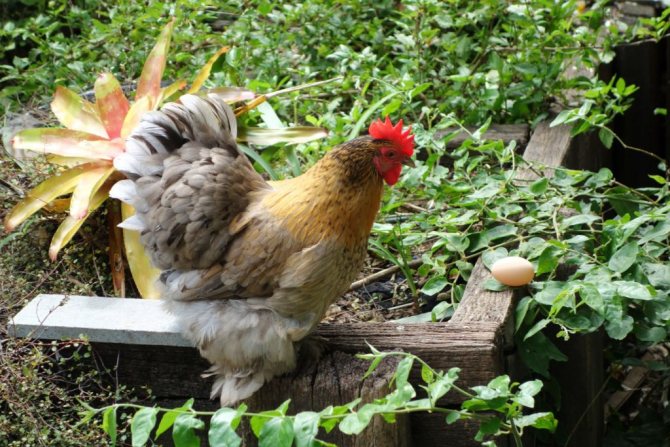

Stressful situations
The stress associated with a change of habitat disappears in about one to two weeks. If, after that, the bird does not enter, the problem should be looked for in something else: in the conditions of keeping, the nutritional value of the feed, the safety of the location of the nest, and health problems. Stress can be caused by a number of reasons:
- moving the laying hen to a new place;
- poor location of nests (loud noise, constant movement around the nest, etc.);
- a rat or other potentially dangerous animal has settled in the chicken coop.
To ensure good egg production, laying hens should be protected from such stressful situations.
Food
Proper nutrition is the key to getting a good volume of eggs from hens. You can not underfeed or overfeed the bird - everything should be in moderation:
- meals 4 times (autumn-winter period);
- three meals a day during free walking in the summer;
- necessarily wet mash, daily;
- the presence of a sufficient amount of clean water in drinking bowls throughout the day, especially in summer;
- strict adherence to standards for feeding layers.
The diet should be varied, include a mixture of cereals, green food, as well as a complex of vitamins and minerals. If you notice the appearance of eggs without shells, then you can give in addition to the main food: shell, crushed chalk, ground eggshells, other natural sources of calcium.
Seasonal changes
The egg production of chickens directly depends on the season. Most of the problems that cause laying hens to stop laying are based on this variable factor.
- Summer. The main summer dangers of a decrease in egg production are diseases, a lack of calcium, and the presence of rat clutches near the nest. If the bird is healthy, not defeated by parasites and rats are not found nearby, then it is possible that the chick is already old or belonged to cross breeds that quickly waste its potential. There are times when the bird itself pecks its eggs due to lack of nutrients.
- Fall. During this period, chickens begin to change plumage. During molting, chickens practically do not rush, the body is resting. There is a way to shift the timing of the process. Molting begins when there is less feed, the temperature gradually decreases, and the daylight hours decreases. In the last week of August, you can drive chickens into a hen house and artificially create an atmosphere of the coming autumn. The molting process will end much earlier than usual, and you will see increased egg production from October to November.
- Winter. At this time, laying hens often have a break. A decrease in the number of eggs obtained from laying hens is a normal phenomenon, but their complete absence indicates a violation of the conditions for keeping birds. In winter, it is very important to control the temperature of the chicken coop, its lighting, to arrange for the birds a sufficient area for normal life, to protect them from animals and predators, and also to provide adequate nutrition.
- Spring. In the spring, many breeders make a very serious mistake - they open the chicken coop too early, allowing cold drafts to get inside. In combination with a lack of vitamins, such a mistake can lead to a break in layers.If this happens, you should not worry too much - as soon as it becomes warm, egg production will improve, but next year the owner must remember his mistake so as not to be left without a sufficient amount of product in the spring. Indeed, in the spring, eggs are needed not only for food, but also for raising offspring of chickens.
So that chickens fly well in winter, spring, summer and autumn
The article is based on personal experience of keeping laying hens, numerous observations of villagers and their chickens and, of course, the scientific approach to modern poultry. This site already had a great article about feeding chickens so that they rush not only in winter, but whenever they want. It was about a grandmother who has a lot of time and not too many chickens; but its folk, such a correct experience for many modern people cannot be reproduced in their own household, and it is not necessary. In order to achieve maximum egg production in chickens, everything can be done much easier.
Let me remind you that chickens of egg breeds (loman, highsek, rhodonite, etc.) must carry 300-320 eggs per year, meat and egg breeds (silver, Kuchin, etc.) - 160-220 eggs per year. Here, the year should be counted from the start of laying. Those. egg chickens should be laid almost every day, and meat and egg chickens every other day or twice every three days. And the fact that chickens can carry in this way in private farmsteads, and not in factories, is not a fairy tale, it has been verified by experience.
Summarize
There are several reasons why layers lay poorly or stop laying eggs altogether:
- malnutrition;
- poor conditions of detention;
- stress;
- the presence of a predator nearby;
- age;
- molting period;
- various diseases;
- incubation instinct;
- wrong choice of breed.
Having determined what exactly the problem is, you can draw conclusions and return the egg to the egg.
Dmitry Vasilievich Morozov
Hereditary poultry farmer, owner of a poultry farm, graduated from St. Petersburg State Agrarian University with honors, author of articles in specialized publications
Useful video on the topic
Like the author! 2
- Even more interesting:
- Proper care and rearing of mulard ducks
- Taking good care of goslings
- Perches for laying hens - do it yourself
Discussion: 3 comments
- Leonid:
10/29/2018 at 11:04 amI still do not understand - when in time does the laying hen stop laying?
Reply
- Olga:
10/29/2018 at 11:05
For how long do layers stop laying ?, thanks in advance
Reply
- Marat:
17.12.2018 at 20:48
I had such a period that the hatching of chickens practically stopped, almost all the chickens stopped laying eggs. I rummaged through the entire Internet, asked my acquaintances what to do to fix this situation, and in the end, the advice given here helped. So they really work and in which case they should be used.
Reply

